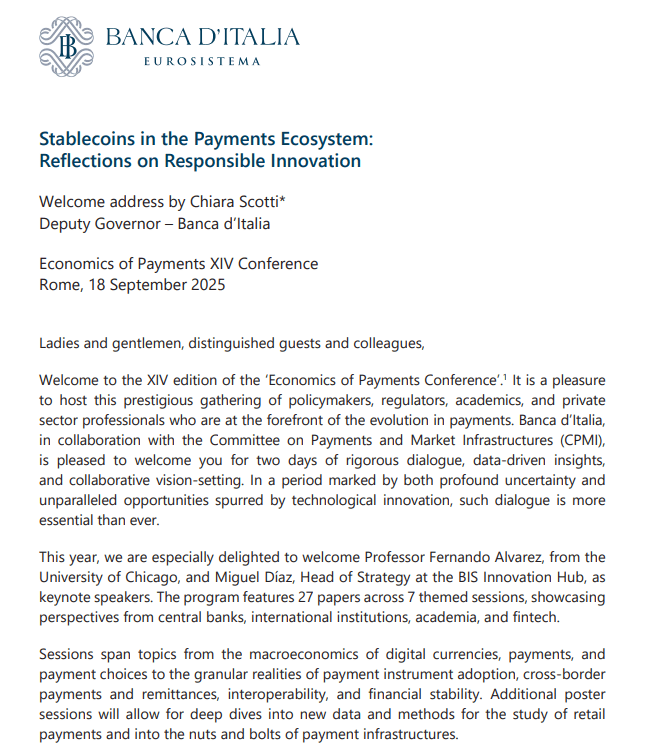Bank of Italy called for tighter rules on multi issuance stablecoins. Vice director Chiara Scotti warned about EU financial stability risks if even one issuer sits outside the bloc. Shespoke at the Economics of Payments Conference in Rome and urged limits to jurisdictions with equivalent regulatory standards. She also stressed redemption at par and clear cross border supervision as core safeguards for stablecoin regulation.
Multi Issuance Stablecoins Risks at Bank of Italy
Chiara Scotti described multi issuance stablecoins as tokens with several legal issuers under one brand. She said the setup may raise global liquidity and scale. However, she warned that the same design can transmit shocks into the European Union.
She stated the risk in direct terms. “Although this architecture could enhance global liquidity and scalability, it poses significant legal, operational, liquidity and financial stability risks at EU level, particularly if at least one issuer is located outside the European Union.” The line highlights the cross border gap in stablecoin regulation.
She then outlined conditions for EU financial stability. Bank of Italy wants redemption at par for users at all times. It also wants tested crisis protocols that work across borders. These points place cross border supervision at the center of the multi issuance stablecoins debate.
MiCA Stablecoins Rules and Where Gaps May Appear
Under MiCA, stablecoins face strict authorization in the EU. Issuers must be EU authorized, and tokens fall into asset referenced tokens or e money tokens. The regime requires reserves, disclosures, and governance that support redemption at par.
MiCA effectively bans algorithmic stablecoins. The law favors fully backed designs with transparent reserves. This approach anchors stablecoin regulation in verifiable assets and clear rights for users.
Yet multi issuance stablecoins test these lines. When a brand uses multiple issuers in and outside the EU, oversight can fragment. Chiara Scotti argued that this split may weaken MiCA outcomes unless authorities enforce aligned cross border supervision and the same equivalent regulatory standards.
Cross Border Supervision, Reserves, and Redemption at Par
Chiara Scotti tied the model to constant oversight. She said the strength of multi issuance stablecoins “hinges on strong cross border cooperation among supervisory authorities, including mechanisms to consistently monitor and verify the adequacy of reserves.” The focus stays on data and reserve checks.
She also noted stablecoins can lower costs and run twenty four seven. She called them useful tools for payments when stablecoin regulation secures reserves and access. These points align with MiCA goals on transparency and user claims.
However, she drew a line on design. “Only stablecoins pegged to a single fiat currency are suitable” as payment instruments, she said. The reason is user protection through redemption at par at nominal value. That view places single currency pegs at the center of EU financial stability policy.
Italy Stablecoins Stance, ESMA Push, and April Risk Flags
Italy has built a firm record on stablecoin regulation. CONSOB joined France and Austria in asking to shift crypto firm oversight to ESMA in Paris. The goal is consistent EU enforcement for stablecoins and service providers.

In late May, Fabio Panetta, now Governor of the Bank of Italy and a former ECB official, said a euro CBDC is the tool to address rising crypto use. His remark followed the Bank of Italy April report focused on stablecoins and corporate crypto exposure. The document singled out risk from dollar pegged tokens.
That April report warned about systemic spillovers. Disruptions in stablecoins or in the US government bonds that back them could spread into other markets. In April, minister Giancarlo Giorgetti also warned that US stablecoin policies may threaten the euro. These references underline the policy link between multi issuance stablecoins, EU financial stability, and ESMA level oversight.

